

PopSci is spending September relearning how to eat. As intuitive as our love of chowing down is, a lot stands between us and optimal eating. This month, we’ll break down diet myths, unlock delicious kitchen hacks, and explore our most common misconceptions about our grub.
There are 300,000 edible plant species you can find outside—at parks and around your home. They are free, they can be delicious and, above all, plentiful.
But when it comes to foraging, not all plants are created equal. Worry not—just by following a few rules you’ll be able to take advantage of this nutritious abundance without becoming ill (or worse).
Find yourself a local guide
It’s not always easy to tell the difference between star-of-Bethlehem and field garlic. That’s why you need someone like Violet Brill, a high school student who co-leads foraging tours in the New York area. Her father, “Wildman” Steve Brill, a foraging enthusiast and author, has been leading excursions since the 1980s, and Violet joined him as a guide at age nine. In this particular case, she advises that you smell the two plants to tell the difference between them. Field garlic has a strong, garlicky scent, whereas the potentially life-threatening star-of-Bethlehem does not.
[Related: You can taste garlic with your feet]
Not only can different species resemble each other but the exact same species can look different depending on where you are. That’s why learning from a¸guide that knows your area well is crucial. For example, “Green Deane” Jordan, a Florida-based forager, says the dandelions he grew up with in Maine appear distinct from those that he occasionally finds in Florida.
Find a safe location
Having food available to you in public places doesn’t mean it’s free for the taking—not at least according to the law. This is why it’s important to check your area’s foraging legislation.
While New York City parks have alternatively ramped up and slowed down on enforcement of park regulations over the years, Brill has been able to forage consistently—except for his famous 1986 arrest in Central Park for harvesting dandelions and a few other edible plants. Brill says that the Parks department dropped the charges and hired him to lead foraging tours for the next four years. No one’s stopped him since.
But regardless of your area’s foraging rules, one principle applies every time, no matter where you are—don’t forage on private property unless you have explicit consent from the landowner. This is especially important in states with harsh trespassing laws, like Texas and North Carolina.
Keep your eye out for other indications that someone has sprayed plants with pesticides, like a physical sign or well-maintained lawn. Don’t eat anything yellowish, wilted, or otherwise unhealthy looking, as these might also be signs of the presence of toxic chemicals.
You should also avoid foraging within 50 feet of traffic, as they tend to be more contaminated than more secluded areas. Jordan says that becoming aware of safe places to forage makes pollution personal. “It’s disheartening to see a persimmon tree full of fruit you can’t eat because it is close to and downhill from the interstate.”
Gather
Now for the fun part—pick your non-poisonous, edible plants. As in all outdoor adventures, travel with a buddy or at least tell someone where you’re going and when you’ll get back. There are many edible invasive plants and weeds out there, like knotweed and some species of pokeweed. It’s a good idea to focus on them to lessen your toll on the ecological neighborhood.
[Related: A quarter of new invasive species were spotted by everyday citizen-scientists]
When you spot something interesting, just pick the renewable parts of the plant, like leaves and berries, as opposed to pulling it out by the roots. As you go, carry mushrooms in paper bags and store greens in plastic bags, possibly with a squirt of water so they don’t wilt.
Cook
When you get home, Violet Brill recommends double-checking your found produce against a book or a trusted website before you start preparing it. Some research will also tell you if you need to boil or roast the species you picked up to remove any toxins. There are dozens of relevant cookbooks (including Steve Brill’s The Wild Vegan Cookbook) that can help you in this task. If you want to keep it simple, you can also use your wild food as a substitute for something else in your favorite dish.
Preserve
While fresh greens are probably better eaten within a few days, if you want to store them for longer, you can blanch them before you put them in the freezer. This will keep them looking green and tasty. You can also prolong the life of your mushrooms for up to twelve months by freezing them. People around the world have come up with many ways to keep their food over the long term, from fermentation to drying to salting, and even canning. A greater variety of fruits and vegetables only means that you have more food to experiment with.
